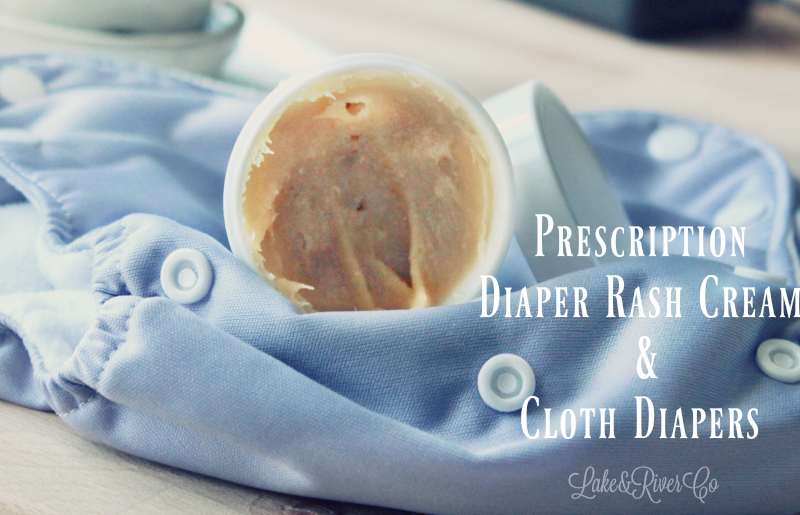
Your baby has been suffering from a stubborn diaper rash that has gone beyond red and now includes open, oozing, bleeding wounds. The natural creams, oil, vinegar, and other remedies haven’t worked. Dang. Time for the big guns. The doctor prescribes “butt paste” or “magic butt cream”.
We have gone through this a few times in our household. And each time, I hold that little tub of “magic butt cream” and wonder…..
What is it? And will it hurt my cloth diapers?
Build-up and repelling are big topics in the cloth diaper community. Many commercial diaper creams are thought to build up in fabric and not rinse out, causing a waxy layer that repels liquid (urine). Hello diaper leaks. There is a well sized market of cloth-friendly creams and balms invested in this problem. And sometimes, natural remedies and balms just aren’t working.
Prescription “magic butt paste” is not to be confused with Boudreaux’s Butt Paste. Pharmacy compounded butt paste is prescription only and contains anti-fungal agents for those stubborn, yeasty diaper rashes.
The ingredients.
- Desitin ointment or cream with zinc oxide
- Nystatin(anti-fungal topical drug) powder
- Cholestyramine powder
- Liquid Mylanta
Or generic equivalents.
The zinc cream reduces redness and acts as an all around barrier.
The Nystatin fights yeast.
Cholestyramine is a bile acid sequester used for lowering cholesterol. It is used topically for diaper rashes for its ability to neutralize bile acids secreted in feces. Basically, it fights irritation from Baby’s “acid poops”.
The Mylanta dries out the oozy parts and reduces acid and itching. You can actually put straight Mylanta or Maalox on a rash much like one does with bug bites.
So…..what about cloth diapers? Is prescription butt paste cloth diaper safe?
Well, it comes down the ingredients, and not every pharmacy will use identical ones. Generics of Desitin and Mylanta might not be exactly the same and may have different carrier oils.
The Nystatin and Colestyramine are in powder form and in small enough amounts to not affect fabric and PUL.
Mylanta/Maalox ingredients amount to
- Aluminum hydroxide (antacid),
- Magnesium hydroxide (antacid)
- Simethicone (anti-gas)
Plus: butylparaben, carboxymethylcellulose sodium, flavor, glycerin, hypromellose, microcrystalline cellulose, potassium citrate, propylene glycol, propylparaben, purified water, saccharin sodium, and sorbitol.
Which really amount to thickeners, flavors, sweeteners, and preservatives. We won’t go into the healthfulness and eco-friendliness of the inactive ingredients. This is a prescription after all. So long as you don’t get something with weird dyes added, the Mylanta/Maalox (or generic) shouldn’t be an issue in regards to delamination or repelling. If there are dyes, they could stain. Otherwise, the glycerins and cellulose shouldn’t be a problem in a warm wash with regular detergent.
Which brings us to the last part.
Desitin or A&D ointment.
This ingredient is the only real concern for your cloth diapers.
There are multiple kinds of Desitin. The Desitin zinc oxide cream in a tube and then the baby specific kind in a jar.
The Baby specific kind in a jar is paraben free and contains:
- Zinc oxide 13% (skin protectant)
- water
- mineral oil
- petrolatum
- beeswax
- dimethicone
- sorbitan sesquioleate
- microcrystalline wax
- PEG-30 dipolyhydroxystearate
- aloe barbadensis leaf extract
- glycerin
- tropolone
- tocopheryl acetate
- 1,2-hexanediol
- caprylyl glycol
- magnesium sulfate
- potassium hydroxide
- phenoxyethanol
In this formula, the beeswax, microcrystalline wax, petrolatum, and mineral oil are the ingredients that could cause problems. Beeswax is a natural ingredient, but it can cause repelling. It requires very hot water to wash out or it will build up. The petrolatum does not specify if it is plain old petroleum jelly or the plant based petrolatum. Some people claim the plant based washes out more easily. Either way, it would need a hot wash to melt it out of the fabric. Same with mineral oil. Mineral oil will wash out with good detergent, it just is a bit more stubborn than coconut or olive oil.
If you look at the tube form of regular Desitin and many equivalents, they often also contain cod liver oil. Some people find fish oils difficult to remove from synthetic fabrics like microfleece. The fish oil build-up is known to get stinky, especially when paired with hard water.
Conclusions
Because of the generic Desitin base in prescription “magic butt paste”, I would recommend using a diaper liner with your cloth diapers to avoid build-up leading to repelling and/or odors. If you don’t use liners, it would be beneficial to wash the affected diaper on an extra hot setting with a strong, powder detergent. If you encounter visible build-up, try rubbing a touch of washing soda into the gummy fabric to break up the film. Be careful not to soak PUL for long in any water softening agent (washing soda, borax, baking soda, etc ) as it can lead to delamination and void your warranty.

